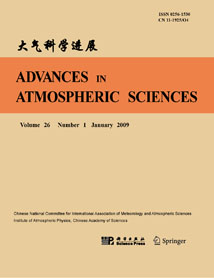| [1] |
Min CHEN, Benedikt BICA, Lukas TÜCHLER, Alexander KANN, Yong WANG,
2017: Statistically Extrapolated Nowcasting of Summertime Precipitation over the Eastern Alps, ADVANCES IN ATMOSPHERIC SCIENCES, 34, 925-938.
doi: 10.1007/s00376-017-6185-4
|
| [2] |
FENG Yerong, WANG Ying, PENG Taoyong, YAN Jinghua,
2007: An Algorithm on Convective Weather Potential in the Early Rainy Season over the Pearl River Delta in China, ADVANCES IN ATMOSPHERIC SCIENCES, 24, 101-110.
doi: 10.1007/s00376-007-0101-2
|
| [3] |
YANG Hongping, Jian ZHANG, Carrie LANGSTON,
2009: Synchronization of Radar Observations with Multi-Scale Storm Tracking, ADVANCES IN ATMOSPHERIC SCIENCES, 26, 78-86.
doi: 10.1007/s00376-009-0078-0
|
| [4] |
Abhay SRIVASTAVA, Dongxia LIU, Chen XU, Shanfeng YUAN, Dongfang WANG, Ogunsua BABALOLA, Zhuling SUN, Zhixiong CHEN, Hongbo ZHANG,
2022: Lightning Nowcasting with an Algorithm of Thunderstorm Tracking Based on Lightning Location Data over the Beijing Area, ADVANCES IN ATMOSPHERIC SCIENCES, 39, 178-188.
doi: 10.1007/s00376-021-0398-2
|
| [5] |
Yang LI, Yubao LIU, Rongfu SUN, Fengxia GUO, Xiaofeng XU, Haixiang XU,
2023: Convective Storm VIL and Lightning Nowcasting Using Satellite and Weather Radar Measurements Based on Multi-Task Learning Models, ADVANCES IN ATMOSPHERIC SCIENCES, 40, 887-899.
doi: 10.1007/s00376-022-2082-6
|
| [6] |
Li Xin, Hu Fei, Liu Gang, Hong Zhongxiang,
2001: Multi-scale Fractal Characteristics of Atmospheric Boundary-Layer Turbulence, ADVANCES IN ATMOSPHERIC SCIENCES, 18, 787-792.
|
| [7] |
MIAO Yucong, LIU Shuhua, ZHENG Hui, ZHENG Yijia, CHEN Bicheng, WANG Shu,
2014: A Multi-Scale Urban Atmospheric Dispersion Model for Emergency Management, ADVANCES IN ATMOSPHERIC SCIENCES, 31, 1353-1365.
doi: 10.1007/s00376-014-3254-9
|
| [8] |
Wen CHEN, Renhe ZHANG, Renguang WU, Zhiping WEN, Liantong ZHOU, Lin WANG, Peng HU, Tianjiao MA, Jinling PIAO, Lei SONG, Zhibiao WANG, Juncong LI, Hainan GONG, Jingliang HUANGFU, Yong LIU,
2023: Recent Advances in Understanding Multi-scale Climate Variability of the Asian Monsoon, ADVANCES IN ATMOSPHERIC SCIENCES, 40, 1429-1456.
doi: 10.1007/s00376-023-2266-8
|
| [9] |
LIANG Qiaoqian, FENG Yerong, DENG Wenjian, HU Sheng, HUANG Yanyan, ZENG Qin, CHEN Zitong,
2010: A Composite Approach of Radar Echo Extrapolation Based on TREC Vectors in Combination with Model-Predicted Winds, ADVANCES IN ATMOSPHERIC SCIENCES, 27, 1119-1130.
doi: 10.1007/s00376-009-9093-4
|
| [10] |
Hengyi WENG,
2012: Impacts of Multi-Scale Solar Activity on Climate. Part I: Atmospheric Circulation Patterns and Climate Extremes, ADVANCES IN ATMOSPHERIC SCIENCES, 29, 867-886.
doi: 10.1007/s00376-012-1238-1
|
| [11] |
FANG Xiaoyi, JIANG Weimei, MIAO Shiguang, ZHANG Ning, XU Min, JI Chongping, CHEN Xianyan, WEI Jianmin, WANG Zhihua, WANG Xiaoyun,
2004: The Multi-Scale Numerical Modeling System for Research on the Relationship between Urban Planning and Meteorological Environment, ADVANCES IN ATMOSPHERIC SCIENCES, 21, 103-112.
doi: 10.1007/BF02915684
|
| [12] |
ZHANG Hanbin, CHEN Jing, ZHI Xiefei, WANG Yi, WANG Yanan,
2015: Study on Multi-Scale Blending Initial Condition Perturbations for a Regional Ensemble Prediction System, ADVANCES IN ATMOSPHERIC SCIENCES, 32, 1143-1155.
doi: 10.1007/s00376-015-4232-6
|
| [13] |
Yuanwen ZHANG, Guiwan CHEN, Jian LING, Shenming FU, Chongyin LI,
2021: A Case Study on MJO Energy Transport Path in a Local Multi-scale Interaction Framework, ADVANCES IN ATMOSPHERIC SCIENCES, 38, 1929-1944.
doi: 10.1007/s00376-021-1098-7
|
| [14] |
Yan GAO, Jiali FENG, Xin XIA, Jian SUN, Yulong MA, Dongmei CHEN, Qilin WAN,
2023: Multi-scale Incremental Analysis Update Scheme and Its Application to Typhoon Mangkhut (2018) Prediction, ADVANCES IN ATMOSPHERIC SCIENCES, 40, 95-109.
doi: 10.1007/s00376-022-1425-7
|
| [15] |
LI Lei, HU Fei, JIANG Jinhua, CHENG Xueling,
2007: An Application of the RAMS/FLUENT System on the Multi-Scale Numerical Simulation of the Urban Surface Layer---A Preliminary Study, ADVANCES IN ATMOSPHERIC SCIENCES, 24, 271-280.
doi: 10.1007/s00376-007-0271-y
|
| [16] |
ZHANG Zuqiang, ZHANG Renhe, Song YANG,
2007: Roles of Multi-Scale Disturbances over the Tropical North Pacific in the Turnabout of 1997--98 El Nino, ADVANCES IN ATMOSPHERIC SCIENCES, 24, 581-590.
doi: 10.1007/s00376-007-0581-0
|
| [17] |
Lu YANG, Cong-Lan CHENG, Yu XIA, Min CHEN, Ming-Xuan CHEN, Han-Bin ZHANG, Xiang-Yu HUANG,
2023: Evaluation of the Added Value of Probabilistic Nowcasting Ensemble Forecasts on Regional Ensemble Forecasts, ADVANCES IN ATMOSPHERIC SCIENCES, 40, 937-951.
doi: 10.1007/s00376-022-2056-8
|
| [18] |
Hengyi WENG,
2012: Impacts of Multi-Scale Solar Activity on Climate. Part II: Dominant Timescales in Decadal-Centennial Climate Variability, ADVANCES IN ATMOSPHERIC SCIENCES, 29, 887-908.
doi: 10.1007/s00376-012-1239-0
|
| [19] |
Yujing QIN, Chuhan LU, Liping LI,
2017: Multi-scale Cyclone Activity in the Changjiang River-Huaihe River Valleys during Spring and Its Relationship with Rainfall Anomalies, ADVANCES IN ATMOSPHERIC SCIENCES, 34, 246-257.
doi: 10.1007/s00376-016-6042-x
|
| [20] |
Peilong YU, Minghao YANG, Chao ZHANG, Yi LI, Lifeng ZHANG, Shiyao CHEN,
2023: Response of the North Pacific Storm Track Activity in the Cold Season to Multi-scale Oceanic Variations of Kuroshio Extension System: A Statistical Assessment, ADVANCES IN ATMOSPHERIC SCIENCES, 40, 514-530.
doi: 10.1007/s00376-022-2044-z
|















 AAS Website
AAS Website 
 AAS WeChat
AAS WeChat 
 DownLoad:
DownLoad: